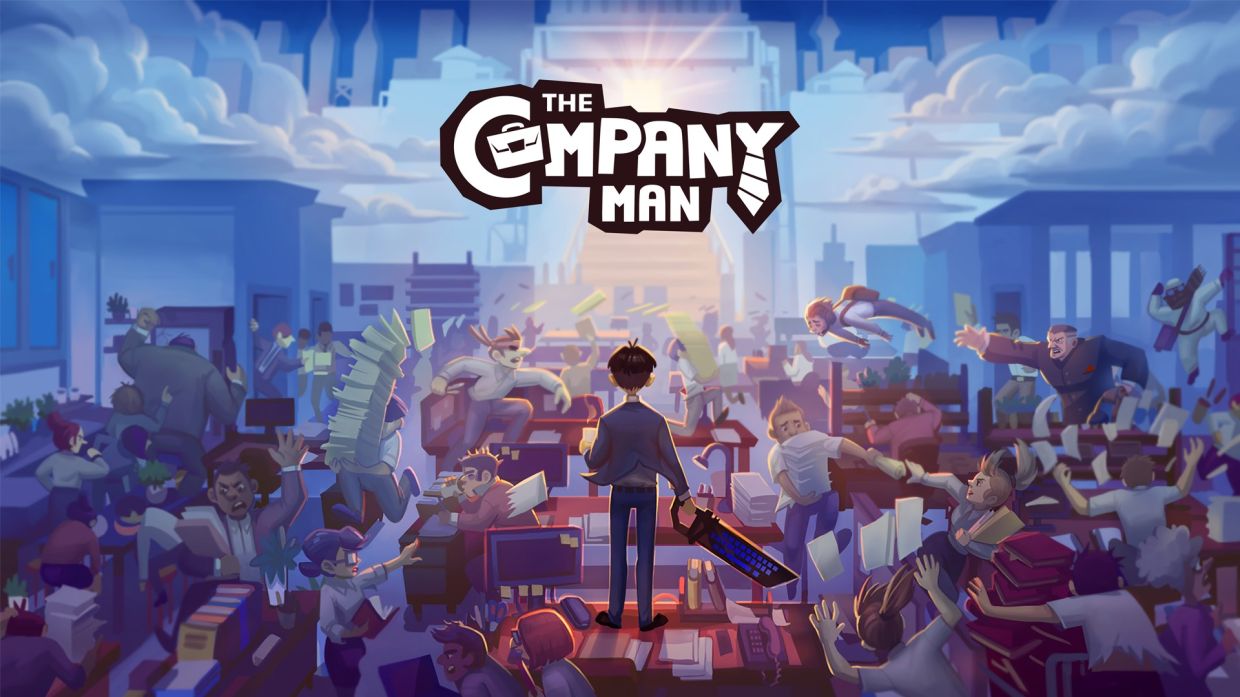At first blush, a corporate office may not seem like the most exciting setting for a fast-paced 2D action platformer. Yet through quirky character design, relatable humour, and inventive game design, the developers at Forust Studio have managed to create a fun game that can appeal to anyone who has ever slaved away at an office.
The Company Man is a 2D action platformer where you control Jim, a fresh graduate entering the workforce for the first time.
Thrust into the corporate world headfirst and forced to fight for his job, he wields a keyboard as a primary weapon and attacks enemy co-workers with e-mails – all while exploring a range of diverse locations inspired by office departments.
Whether venturing into the frozen halls of the overly air-conditioned accounting department or scaling the mountains of paperwork in the human resources department, the game’s tone is humorous – fixing its audience with a knowing smile as it parodies concepts like overpriced coffee shops granting player upgrades, or the head of HR tossing interns around in its attack.
Relatable office humour
This sense of humour is informed by the developers having served their time in corporate hell themselves, as well as the sitcom The Office.
Andrew Teo, CEO and founder of Forust Studio, says, “It was an idea I came up with when I was in my previous workplace. It wasn’t a crazy toxic workplace like that expressed in the game, but it was basically a low-heat, constant pressure cooker environment that created The Company Man in my mind.
“I got to work in a corporate tower, so I got to see the different departments, different cliques and how people had different communication styles. I wanted to express that as an extreme personification of different workplace personalities. For instance, the accounting department’s cold personalities are reflected in how their airconditioning is always colder than everyone else’s.
“In terms of humour, we loved The Office,” Teo continues. “Between my art director and myself, we probably watched the show on loop like 20 times. We loved the kind of humour where the situations are funny, not just the jokes. We really wanted to make sure the situations we put our characters in had that kind of physical or absurdist comedy.”
Artistic influences
The game also sports a striking anime-esque aesthetic. Little wonder then that the game has found no small success in Japan.
“A lot of our art style and animation really resonated with the Japanese audience,” Teo says. “We designed the game with a lot of anime references as well. Stuff we grew up with.”
One has to wonder as well if Japan’s infamous salaryman culture had any impact on The Company Man’s reception. Many of the situations encountered in the game would have likely been familiar to Japan’s myriad office workers.
“One of the first games that made me want to choose this path as a video game designer myself was this game called Bastion,” Teo says. “It was made by a small team as well, and that was something that was inspiring for me, and provided a scope for us to strive for. Bastion had excellent storytelling, and that was something we wanted to achieve as well with The Company Man.”
Being a sidescrolling 2D action platformer, The Company Man shares a lot of DNA with classic games like Mega Man, as well as more modern hits like Hollow Knight.
“We wanted to have those kinds of gameplay mechanics in our game too,” Teo says. “Very responsive timing, very quick animations. But at the same time, we wanted to add our own twists.”
Learning on the job
The Company Man is Forust Studio’s very first game, with an entirely Malaysian team. No one in the team had actually worked on a video game of this scope from start to finish.
“It was a huge learning curve,” Teo says. “I come from a business background, I studied marketing and finance at university. Taking on the role of lead game designer, I had to learn everything from scratch. Watching YouTube tutorials, reading forums. We even consulted directly with the video game engine Unity.
“One interesting thing that happened was the game froze up for someone in Turkey. In Malaysia we use commas for every thousand digits, but in some other countries, they use a full stop. So if we didn’t set the code to read the English language, it would change to the local language and it would cause a bug to happen. All sorts of weird things happened. We’re one of the first few to ship a game in Malaysia, so we had to learn the hard way.”
Due to Teo and the team’s vision of the game being of a traditional 2D animated style, the animators who only had experience in 3D animation had to learn a lot from scratch as well. Like a flipbook, each frame was drawn by hand and then animated.
“We even had to go through one round of redesigning our animation style,” Teo says. “One feedback we received was that the characters needed to be more expressive. The characters were just so tiny on screen.
“We needed to make their poses very pronounced, so that their actions and personalities could be seen from far away despite being small. If they’re lazy, excited, or angry, you need to be able to tell just from the position of the arms and legs.”
Teo credits his programmer, TJ, for advising him to keep the level designs and boss fights aesthetically and thematically consistent with each other.
Teo says, “For example, the accountant floor was designed with the concept of balancing scales, as accountants balance books in their everyday work. We came up with scales, and using those scales in the boss fights was very fun for us. The player has to offset the scales to go higher and hit the boss.”
After hours
Due to their inexperience, Forust Studio had relatively low expectations regarding the reception of the game. They were pleasantly surprised by the critical and commercial success the game ended up enjoying.
“I’m happy that it connected,” Teo says. “We didn’t expect our largest market to be in Japan, so we’re very hopeful that we can continue to build on that. It even got featured on Japanese television and gaming magazines.”
The anime art style will continue to be a central feature of Forust Studio’s future games.
“We wrote some of the jokes in the game three years before anyone actually saw them,” Teo says.
“We don’t even laugh at some of these jokes anymore. For the accountant boss, we had this spider lady with a giant calculator, and it sort of became, like, that’s just her. But when we showcased it at the Tokyo Game Show and we saw people laughing until their stomachs hurt, that’s something that was very satisfying for us. More than the sales figures, the fact that the content actually connected with someone.”
For aspiring game developers, Teo advises them to try to understand who their potential players are going to be. “Think about how your content is going to be relevant to the audience you want,” Teo advises.
“For example, if you’re making a game about football, it might be easier to find an audience in Europe compared to the US. Find out what these people like and also make sure that that overlaps with something you like, because you’re going to be working on this for 3 years or so.
“Once you find that sweet spot, I think you’ll have a niche you can really build on.”











